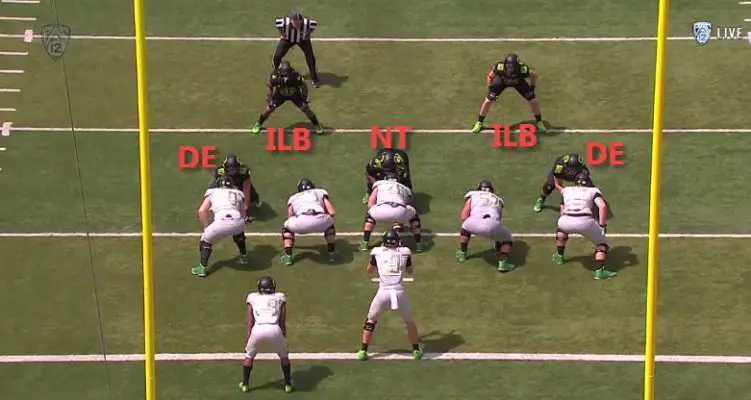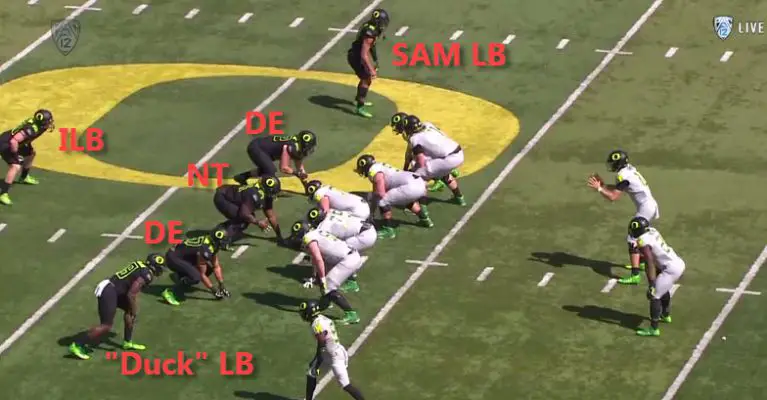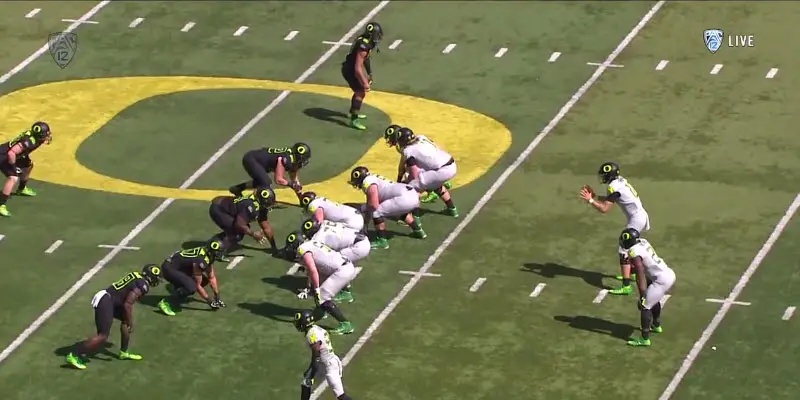Charles Fischer [the head man at FishDuck.com] keeps telling me that many fans, and he, are confused about the configuration of the Oregon front 7: the defensive linemen and linebackers [LBs]. So let’s have a look.
At first glance, Coach Jim Leavitt’s most used/base front, appears to be a typical 3 [linemen]-4 [LBs] defense. But the devil’s in the details; there are many ways to execute the 3-4 defense. What’s unique about the way Oregon plays defense?
The Nose Tackle almost always plays a 0 technique. Many NTs play a 1 technique, “shading” to a specific side of the center, or stunt to a specific gap. Not Oregon’s; unless they blitz from this alignment, which is very rare. The NT tries to drive the center straight back into the backfield, and then separate from that blocker, and be responsible for either A gap. (A “2-gap” technique) To be able to do this, the NT must be huge [at least 310] and very strong. Speed is not a necessity as the NT is usually substituted for by a faster pass rusher in passing situations.

Every shade of positioning is important….
The Ducks’ defensive ends are “typical” – at least 6’4″, 270-285 pounds. They must be big and strong enough to defeat offensive tackles, and yet fast enough to contain on passes when they play a 5 technique [attacking the outside shoulder of the offensive tackle, with C gap responsibility].
The DEs become DTs [using a 3 or 1 technique] when the Ducks use their “even” 4-2 front. But because they only do this in passing situations, the DEs don’t have to be as big as typical “even-front” DTs.
The defensive ends also use the 4 technique [attacking the inside shoulder of the OT, with initial B gap responsibility, [but a 2-gap technique]. The DEs don’t try to disguise this; the DE lines up with his outside foot between the OT’s feet. In order to use the 4 technique, the OLB on that side must blitz to contain. When the OLB is blitzing on a side with no TE, Leavitt prefers the defensive end to use a 4 technique. Leavitt also really likes to use the “404” defense, with both OLBs blitzing and both DEs using a 4 technique.
The inside linebackers have almost identical physical requirements and responsibilities as they did in Brady Hoke‘s 4-3 defense. That’s a big reason A.J. Hotchkins had such an outstanding spring, and Troy Dye was a bit behind [Troy was an OLB last year and has moved to Inside Linebacker this year].

ILBs right in front of the offensive guards.
Both Inside Linebackers are in a 30 alignment, over the guards, with the Will (Weakside) ILB on the side opposite the Duck OLB [usually the short side of the field], and the Mike ILB lined up between them. This is done for pass coverage purposes: The Will LB has the no. 2 receiver (Second WR from the sideline) to his side as his pass key, and Mike LB has the no. 3 receiver. Because they are almost always in man coverage, speed is much more essential than size for an ILB.
On running plays, the Inside Linebacker to the “flow” side or playside, has the B gap [if the DE is using a 5 technique] or C gap [if the DE is using a 4 technique]. The back-side ILB [away from flow] helps his NT by filling an open A gap [usually to the flow side].
Are you still with me? Not so unique so far. But the “so-called” outside linebackers are about to change that. Because neither OLB is a “typical” OLB.

Oregon primary defensive front.
The Sam, or strongside OLB is always lined up [usually to the short side] and opposite the new Hybrid OLB/Safety “Duck” OLB , on the line of scrimmage, in a wide 9 alignment. But this Sam OLB is actually a [stand-up] defensive end, as I have yet to see him drop into coverage on a pass. He essentially blitzes on every down, with contain responsibility. In passing situations, another of these [so-called] Sam OLBs replaces the NT, and both OLBs blitz and contain, as defensive ends.
Obviously these players are selected for their pass rushing ability. Denver’s Von Miller is the prototype. They don’t need to have pass coverage skills or the instincts [“football smarts”] of an ILB.
The other OLB – the “Duck“is actually a safety, lined up as an OLB [usually to the wide side]. He brings more speed and pass coverage skills, but with the same responsibilities as a regular OLB. The Duck must be big and tough enough to be a force-contain defender against a lead blocker.
The Duck blitzes – a lot. His pass coverages don’t change when Oregon switches to its balanced 4-2 front (as in above) in passing situations. They’re already in their “nickel [5 DBs]” defense.
So now, Charles Fischer thinks it’s important that I give a correct “numerical title” to Oregon’s new base defense. I don’t. Heck, Buddy Ryan called his famous Chicago Bear defensive scheme, the “46” defense – just because he liked the sound of that. Today every coach just calls it the “Bear” defense. There was an “Okie”, and “Eagle” defense.
But Charles thinks it’s important, so here goes [drum roll, please]: The Oregon Ducks use an “odd [meaning there is a nose tackle over the center] 4-2-5” defensive front most of the time. They supplement this front with an “even [the center is uncovered] 4-2-5” defensive front. Got it?
To me, it’s just the Oregon Ducks’ Defense, and I’m really looking forward to seeing it in action next season.
Coach Mike Morris
Pleasant Hill, Oregon
Top Photo from Pac-12 Network Video
(Note: like everyone else–coaches can disagree about what to call a defense or an alignment. While Mike has the definitions above, others might just call the 4-2-5 variation on passing downs as the “Two-fer” defense (written about recently) for fun. Charles Fischer)
Related Articles:
Coach Mike Morris spent 30 years coaching at seven different high schools throughout Southern California. He coached many players who went on to Pac-12 programs including Oregon, such as Saladin McCullough. He is a writer, Football analyst and a good friend of the Principal of the site.

